#this is alice and martin provensen’s iliad/odyssey
Text
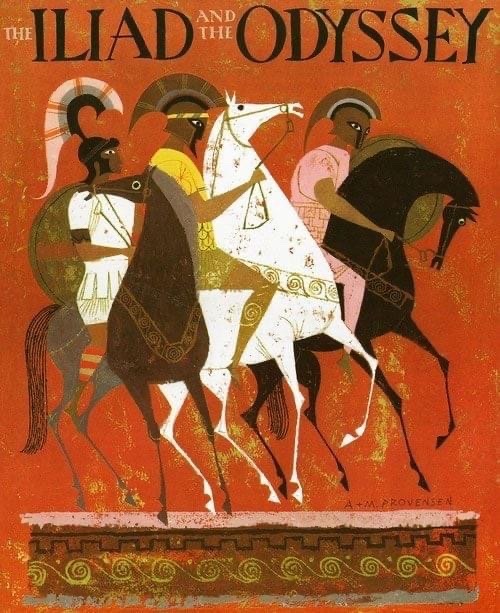
THE ILIAD AND THE ODYSSEY (NY: Golden Press, 1956). Illustrated by Alice and Martin Provensen. A Great Golden Book.





#beautiful books#books books books#book blog#book cover#books#illustrated book#1950s#vintage books#the iliad#the odyssey#homer#children’s book
29 notes
·
View notes
Photo

【素敵な洋書絵本の紹介】 日本でもたくさんの絵本が翻訳されて愛されているアリス&マーティン・プロベンセンの1947年から2005年までのアートワークをまとめた本です。 その生涯で40冊以上の絵本を作り、多くはニューヨークタイムズのベストイラストレーションブック・オブ・ザ・イヤーリストに登場しました。 マーガレット・ワイズ・ブラウンの『The Color Kittens』(1949年)の初期の作品から、コールデコット賞を受賞したタイトル「The Glorious Flight: Across the Channel with Louis Bleriot」(1983年)まで、プロベンセンの本はたくさんの子どもたちに影響を与えています。 1951年の『A Child's Garden of Verses』、1959年の『The Iliad and the Odyssey』、1960年の『Myths and Legends』など、古典の原画が美しく再現された絵本も収録されています、 娘のカレン・プロベンセン・ミッチェルとのインタビューは、彼らの人生とキャリアを照らし、アーカイブから多くの写真、引用、スピーチ、記録も収録されています。 プロベンセン夫妻のアートワークを一度にたくさん眺めると、表現の豊かさやその色彩の美しさに圧倒されてしまいます。 The Art of Alice and Martin Provensen Contributor(s): Provensen, Alice (Author), Provensen, Martin (Author), Marcus, Leonard (Contribution by), Gottlieb, Robert (Contribution by), Provensen Mitchell, Karen (Contribution by) EAN: 9781797209586 Publisher: Chronicle Chroma Binding: Hardcover Pub Date: March 01, 2022 Physical Info: 2.54 cms H x 21.08 cms L x 30.48 cms W (1.52 kgs) 240 pages #aliceandmartinprovensen #readleafbooks #art #本 #本棚 #絵本 #児童書 #絵本屋 #洋書絵本 #絵本が好き #絵本が好きな人と繋がりたい #絵本のある暮らし #芸術 #英語 #イラスト #base #baseec @readleafbooks Webショップで紹介中。プロフィールからぜひどうぞ! https://www.instagram.com/p/CeHsX2-Pev0/?igshid=NGJjMDIxMWI=
#aliceandmartinprovensen#readleafbooks#art#本#本棚#絵本#児童書#絵本屋#洋書絵本#絵本が好き#絵本が好きな人と繋がりたい#絵本のある暮らし#芸術#英語#イラスト#base#baseec
1 note
·
View note
Text
obsessed with this little drawing of menelaus beating the shit out of paris
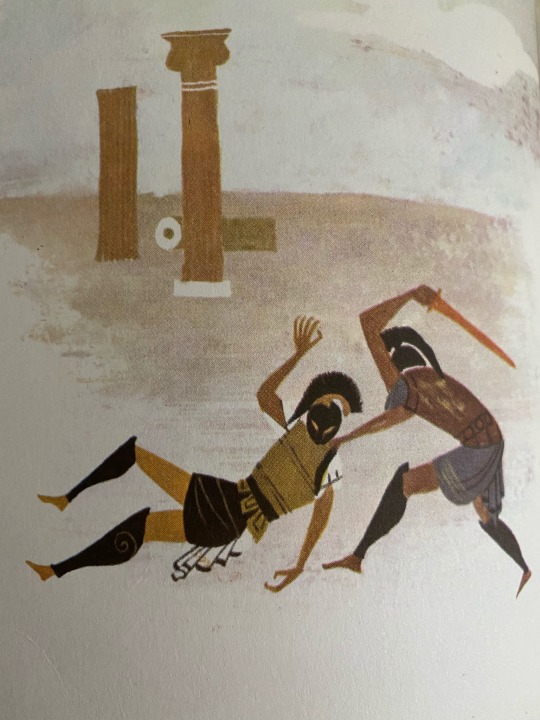
#this is alice and martin provensen’s iliad/odyssey#such a pretty book im so happy to now own it#honestly? might make this my menelaus tattoo#fuck him up kenneth fuck em up#achileid.txt
55 notes
·
View notes
Text
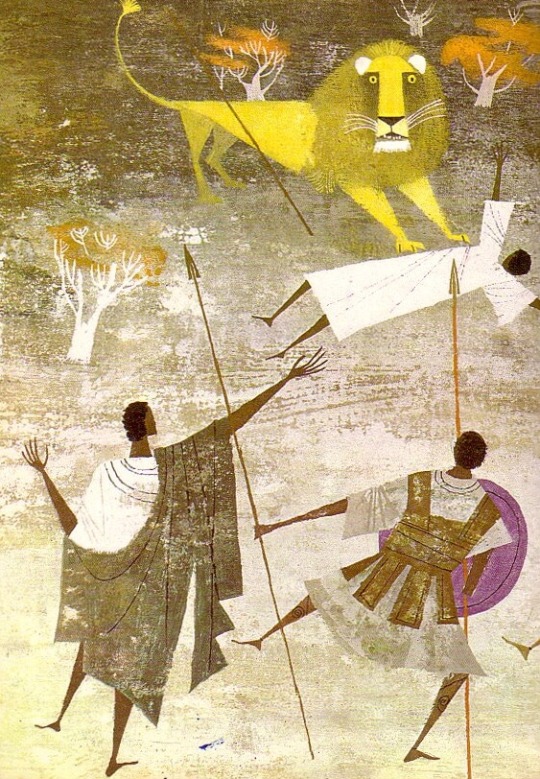


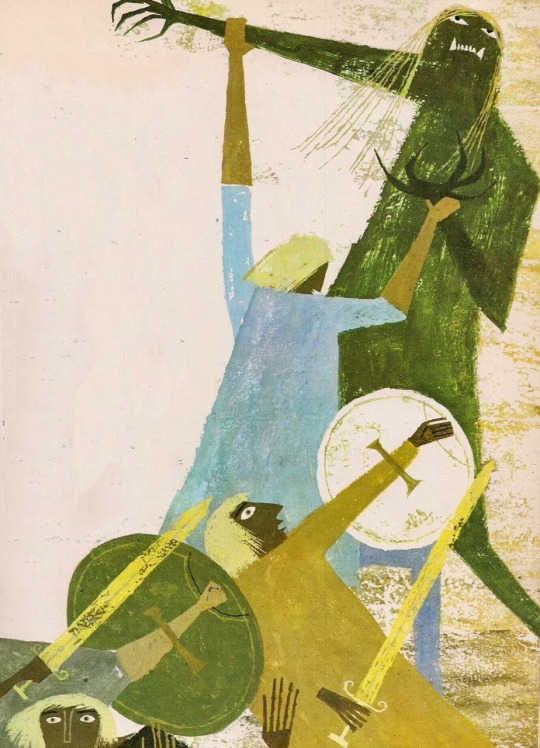


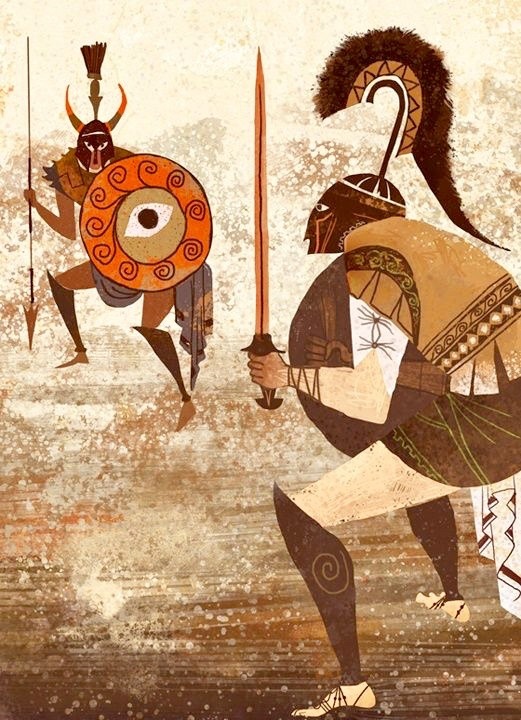
Greek myths and stories by illustrator duo, Alice and Martin Provensen. 1950s/1960s.
#art#vintage#illustration#greek#myths#iliad#odyssey#homer#mythology#golden treasury#alice#martin#provensen#illustrations#book illustration#1950s#60s#greece
6K notes
·
View notes
Text
Vintage Iliad and Odyssey Illustrations by Alice and Martin Provensen





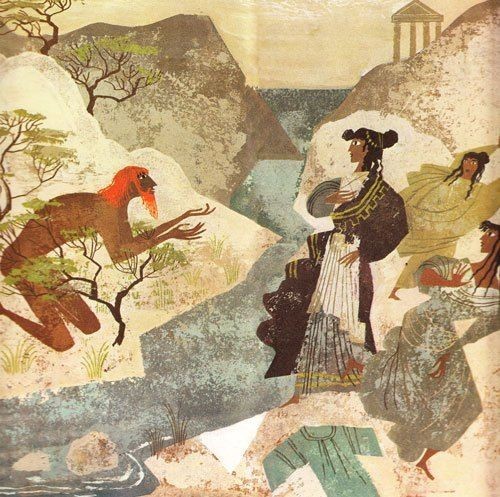



22 notes
·
View notes
Photo

llustration by Alice and Martin Provensen from ‘The Iliad and the Odyssey A Giant Golden Book’
5 notes
·
View notes
Photo
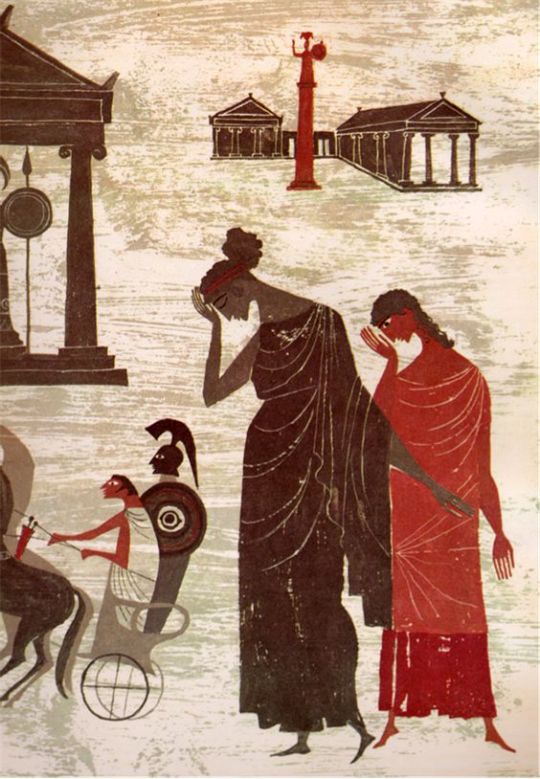
The Iliad and the Odyssey:The Heroic Story of the Trojan War and the Fabulous Adventures of Odysseus - adapted from the Greek classics of Homer by Jane Werner Watson, illustrated by Alice and Martin Provensen (1956).
#iliad#odyssey#epic stories#trojan war#Odysseus#Homer#Greeks#Greece#Jane Werner-Watson#illustration#Alice and Martin Provensen#1956#classics#ancient Greece
40 notes
·
View notes
Note
can i ask where u draw inspiration from vis-a-vis drawing greek clothing? whenever i try to research the topic myself, i feel like i come out of it more confused than i were before. how do you deal with the entire issue of like, diff customs based on diff time periods or locations, the question of how fragmentary our data is on the whole thing, and also "how do i wrap my head around drapey 3d garments" lmao. ESP the stuff you usually draw orestes in looks so interesting! where is that from? :O
Honestly, usually I simplify clothing a fair amount and sometimes that comes at the expense of historical accuracy. It’s not that I haven’t researched it— I have several books on the subject, essays I’ve saved and highlighted that go into the specific details for the Iliad characters’ attire, etc— but with my art, I made the decision I didn’t want that to be the focus. There are plenty of artists who have done a fantastic job drawing period accurate clothing— the Age of Bronze series is great for that. Peter Connolly’s illustrations as well. However, something I have noticed consistently about art that does so is because the clothing, and especially the armor, is so detailed, the focus of the drawing becomes about what the character is wearing, not the character. Movement, gesture and anatomy especially tend to become lost in a lot of the multilayered, bulky garments of the time (or take three times as long to communicate as clearly). Which, depending on what your focus is, could be fine— and I have a ton of respect for those artists for having that kind of patience tbh. But since my main focus with my art is more on communicating the character’s personality and their interactions with others, I decided to kind of downplay that element at the expense of some historical accuracy. Artists I draw inspiration from in this respect are Alice and Martin Provensen’s Iliad and Odyssey, John Flaxman’s Iliad, and Victor Ambrus’ Iliad. The latter has a great book on historical costume design, but even knowing as much as he does, he still simplified or changed a lot which in turn made for drawings that have incredible gesture and design. (I would be giving linked examples for all of this, but I’m on tumblr mobile for 2 more weeks which is barely functional at best :|) As for Orestes’ outfit, that’s also rather inaccurate and based purely on the 1962 Electra movie. I use it because I feel like it fits the character and it’s fun to draw :,) (at least in my sketches; like everything else, I’ve made some tweaks in my upcoming comics to have a better balance in terms of accuracy and artistic license)
22 notes
·
View notes
Photo
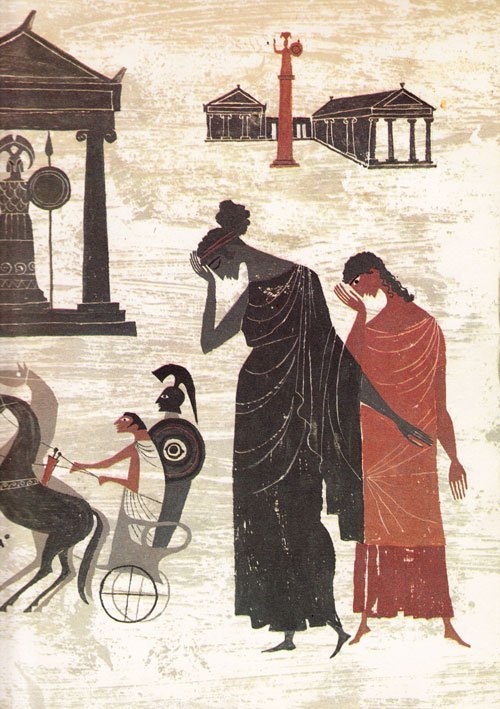
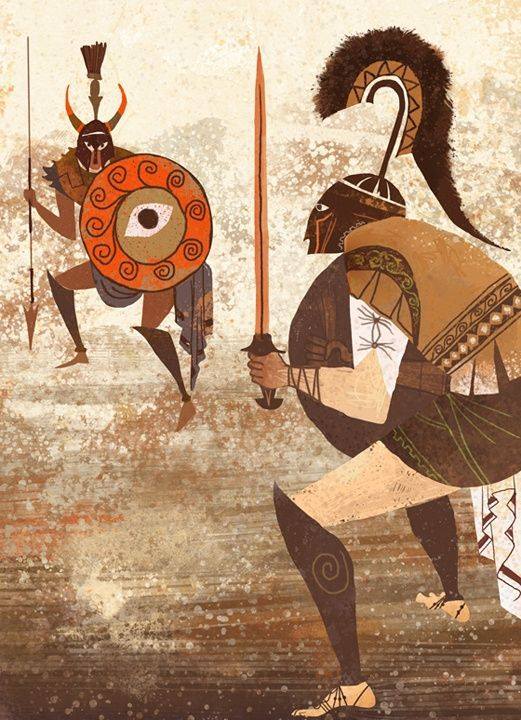


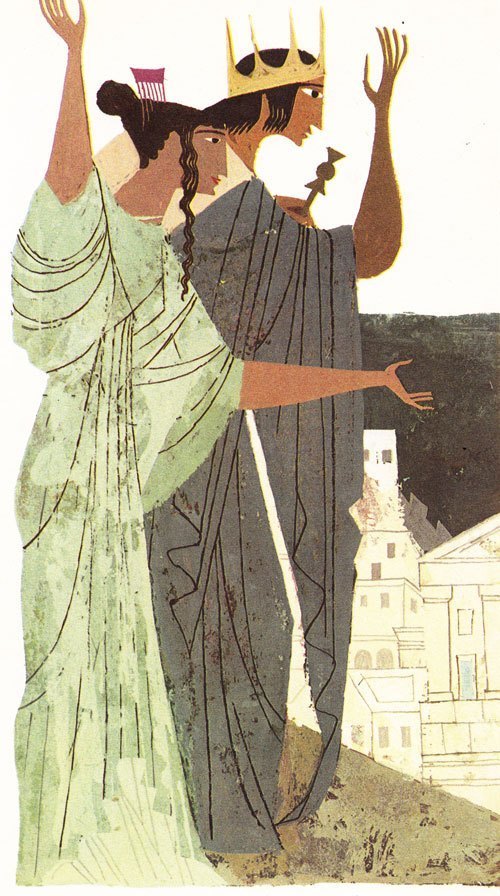
Alice and Martin Provensen (1918-2018 and 1916-1987 respectively)
Illustrations for The Iliad and the Odyssey: A Giant Golden Book (1956)
33 notes
·
View notes
Photo

The Iliad and the Odyssey: A Giant Golden Book (1956)Illustrations by Alice and Martin Provensen.
85 notes
·
View notes
Photo

Vibrant Vintage Illustrations of Homer’s Iliad and Odyssey by Alice and Martin Provensen
0 notes
Photo

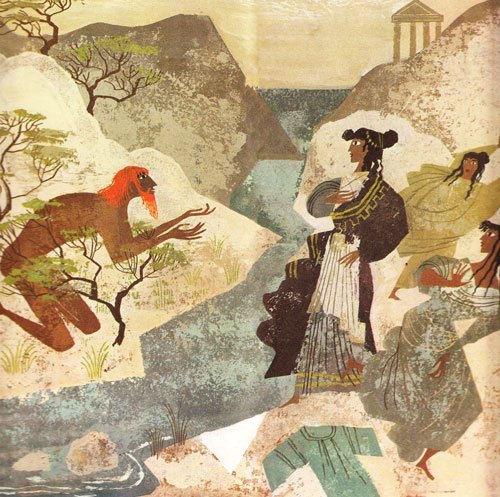


The Iliad and The Odyssey (1956)
Martin and Alice Provensen
#greek mythology#i love the tiny chariot man and the cursed horse#these are my favorite of that photoset- there are more- but THESE
10 notes
·
View notes
Link
I found this on pinterest , thought it looked pretty cool!
0 notes
Photo

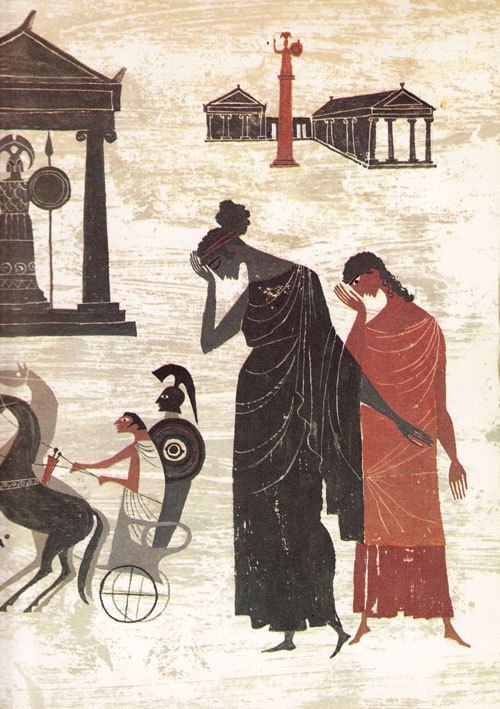


(via Vibrant Vintage Illustrations of Homer’s Iliad and Odyssey by Alice and Martin Provensen – Brain Pickings)
0 notes
Text
Still Capturing Imaginations: The Legend of Troy
Still Capturing Imaginations: The Legend of Troy
Art from The Iliad and the Odyssey: A Giant Golden Book adapted from the Greek classics of Homer by Jane Werner Watson and vividly illustrated by Alice and Martin Provensen
The legend of Troyhas endured for more than 3,000 years, and continues to inspire artists and writer today. The story of a great city, plunged into a 10-year war over the abduction of the most beautiful woman in the world, is…
View On WordPress
#Alice and Martin Provensen#British Museum#Candlewick Press#Gareth Hinds#Heinrich Schliemann#Jane Werner Watson#The Iliad#Troy#Troy Exhibition
0 notes
Text
The Search for a New Humility: Václav Havel on Reclaiming Our Human Interconnectedness in a Globalized Yet Divided World
“Our respect for other people… can only grow from a humble respect for the cosmic order and from an awareness that we are a part of it… and that nothing of what we do is lost, but rather becomes part of the eternal memory of being.”
In his clever 1958 allegory I, Pencil, the libertarian writer Leonard Read used the complex chain of resources and competences involved in the production of a single pencil to illustrate the vital web of interdependencies — economic as well as ethical — undergirding humanity’s needs and knowledge. “We are caught in an inescapable network of mutuality,” Dr. King wrote from Birmingham City Jail five years later, as the material aspects of our interconnectedness became painfully inseparable from the moral. “Whatever affects one directly, affects all indirectly.”
How to inhabit our individual role in that mutuality with responsible integrity is what the great Czech dissident Václav Havel (October 5, 1936–December 18, 2011) addressed in his 1995 Harvard commencement address, later published under the title “Radical Renewal of Human Responsibility” in his collected speeches and writings, The Art of the Impossible: Politics as Morality in Practice (public library).
Václav Havel
Havel — a man of immense erudition and literary genius, who embodied Walt Whitman’s insistence that literature is essential for democracy, who went from playwright to president, who endured multiple imprisonments to uphold his ideals of justice, humanism, anti-consumerism, and environmental responsibility — begins by recounting an incident that sobered him to the irreversible forces of globalization: Sitting at a waterfront restaurant one evening, watching young people drink the same drinks as those served in his homeland to the sound of the same music that fills Prague’s cafés, surrounded by the same advertisements, he is reminded of the fact that he is in Singapore only by the different facial features of his fellow diners.
A decade before the social web subverted geography to common interests, values, and sensibilities as the centripetal force of community formation, Havel writes:
The world is now enmeshed in webs of telecommunication networks consisting of millions of tiny threads, or capillaries, that not only transmit information of all kinds at lightning speed, but also convey integrated models of social, political and economic behavior. They are conduits for legal norms, as well as for billions and billions of dollars crisscrossing the world while remaining invisible even to those who deal directly with them…. The capillaries that have so radically integrated this civilization also convey information about certain modes of human co-existence that have proven their worth, like democracy, respect for human rights, the rule of law, the laws of the marketplace. Such information flows around the world and, in varying degrees, takes root in different places.
And yet, with prescience painfully evident two decades later, Havel cautions that there is a dark side to this undamming of information and ideas:
Many of the great problems we face today, as far as I understand them, have their origin in the fact that this global civilization, though in evidence everywhere, is no more than a thin veneer over the sum total of human awareness… This civilization is immensely fresh, young, new, and fragile, and the human spirit has accepted it with dizzying alacrity, without itself changing in any essential way. Humanity has gradually, and in very diverse ways, shaped our habits of mind, our relationship to the world, our models of behavior and the values we accept and recognize. In essence, this new, single epidermis of world civilization merely covers or conceals the immense variety of cultures, of peoples, of religious worlds, of historical traditions and historically formed attitudes, all of which in a sense lie “beneath” it. At the same time, even as the veneer of world civilization expands, this “underside” of humanity, this hidden dimension of it, demands more and more clearly to be heard and to be granted a right to life.
And thus, while the world as a whole increasingly accepts the new habits of global civilization, another contradictory process is taking place: ancient traditions are reviving, different religions and cultures are awakening to new ways of being, seeking new room to exist, and struggling with growing fervor to realize what is unique to them and what makes them different from others. Ultimately they seek to give their individuality a political expression.
With an eye to the dangerously disproportionate dominance of Euro-American values in this global marketplace of values and ideas, Havel writes:
It is a challenge to this civilization to start understanding itself as a multicultural and a multipolar civilization, whose meaning lies not in undermining the individuality of different spheres of culture and civilization but in allowing them to be more completely themselves. This will only be possible, even conceivable, if we all accept a basic code of mutual coexistence, a kind of common minimum we can all share, one that will enable us to go on living side by side. Yet such a code won’t stand a chance if it is merely the product of a few who then proceed to force it on the rest. It must be an expression of the authentic will of everyone, growing out of the genuine spiritual roots hidden beneath the skin of our common, global civilization. If it is merely disseminated through the capillaries of the skin, the way Coca-Cola ads are – as a commodity offered by some to others – such a code can hardly be expected to take hold in any profound or universal way.
Illustration from Alice and Martin Provensen’s vintage adaptation of Homer’s Iliad and Odyssey
Acknowledging that such a line of thought might be dismissed by cynics as unrealistically utopian, Havel insists on not losing hope — lucid hope. “This is an extraordinary time full of vital, transformative movements that could not be foreseen,” Rebecca Solnit would write a generation later in her electrifying manifesto for civilizational resilience. “It’s also a nightmarish time. Full engagement requires the ability to perceive both.”
A decade before philosopher Jonathan Lear made his case for “radical hope,” Havel writes:
I have not lost hope because I am persuaded again and again that, lying dormant in the deepest roots of most, if not all, cultures there is an essential similarity, something that could be made if the will to do so existed – a genuinely unifying starting point for that new code of human co existence that would be firmly anchored in the great diversity of human traditions.
He points out that at the heart of every spiritual tradition, no matter its geographic or temporal origin, is a set of common moral principles upholding values like kindness, benevolence, and respect for human dignity. And yet, in an era of such irreversible triumphs of science as the splitting of the atom and the discovery of DNA — triumphs which Einstein believed united humanity through “the common language of science” — any real movement toward healing the ruptures of our natural interconnectedness lies not in reverting to ancient religions but in integrating the achievements of reason with the core values of the human spirit. Half a century after pioneering biologist and writer Rachel Carson invited us to step out of the human perspective, Havel writes:
Only a dreamer can believe that the solution lies in curtailing the progress of civilization in some way or other. The main task in the coming era is something else: a radical renewal of our sense of responsibility. Our conscience must catch up to our reason, otherwise we are lost.
It is my profound belief that there is only one way to achieve this: we must divest ourselves of our egotistical anthropocentrism, our habit of seeing ourselves as masters of the universe who can do whatever occurs to us. We must discover a new respect for what transcends us: for the universe, for the earth, for nature, for life, and for reality. Our respect for other people, for other nations and for other cultures, can only grow from a humble respect for the cosmic order and from an awareness that we are a part of it, that we share in it and that nothing of what we do is lost, but rather becomes part of the eternal memory of being, where it is judged.
Illustration by Soyeon Kim from Wild Ideas
Havel calls for “the search for a new humility” — a search that politicians have an especial responsibility to enact:
Even in the most democratic of conditions, politicians have immense influence, perhaps more than they themselves realize. This influence does not lie in their actual mandates, which in any case are considerably limited. It lies in something else: in the spontaneous impact their charisma has on the public.
In a passage of bittersweet poignancy against the contrast of our present political reality, Havel adds:
The main task of the present generation of politicians is not, I think, to ingratiate themselves with the public through the decisions they take or their smiles on television. It is not to go on winning elections and ensuring themselves a place in the sun till the end of their days. Their role is something quite different: to assume their share of responsibility for the long-range prospects of our world and thus to set an example for the public in whose sight they work. Their responsibility is to think ahead boldly, not to fear the disfavor of the crowd, to imbue their actions with a spiritual dimension (which of course is not the same thing as ostentatious attendance at religious services), to explain again and again both to the public and to their colleagues – that politics must do far more than reflect the interests of particular groups or lobbies. After all, politics is a matter of servicing the community, which means that it is morality in practice, and how better to serve the community and practice morality than by seeking in the midst of the global (and globally threatened) civilization their own global political responsibility: that is, their responsibility for the very survival of the human race?
Standing before “perhaps the most famous university in the most powerful country in the world,” Havel issues a particularly urgent exhortation to American politicians:
There is simply no escaping the responsibility you have as the most powerful country in the world.
There is far more at stake here than simply standing up to those who would like once again to divide the world into spheres of interest, or subjugate others who are different from them, and weaker. What is now at stake is saving the human race. In other words, it’s a question of what I’ve already talked about: of understanding modern civilization as a multicultural and multipolar civilization, of turning our attention to the original spiritual sources of human culture and above all, of our own culture, of drawing from these sources the strength for a courageous and magnanimous creation of a new order for the world.
With a cautionary eye to “the banal pride of the powerful” — corruption of character which Hannah Arendt followed to its gruesome extreme in her timeless treatise on the banality of evil — Havel adds:
Pride is precisely what will lead the world to hell. I am suggesting an alternative: humbly accepting our responsibility for the world.
Looking back at his own life with the astonishment of one who grew up under the locked-in nationalism of a communist authoritarian regime, then went on to travel to places like Singapore and address the graduating class at Harvard, Havel ends on a note of radical, responsible hope:
I have been given to understand how small this world is and how it torments itself with countless things it need not torment itself with if people could find within themselves a little more courage, a little more hope, a little more responsibility, a little more mutual understanding and love.
Complement this fragment of Havel’s wholly ennobling Art of the Impossible with other exceptional commencement addresses — including 21-year-old Hillary Rodham on making the impossible possible and Joseph Brodsky on our mightiest antidote to evil — then revisit Eleanor Roosevelt on the power of personal responsibility in social change.
donating = loving
Bringing you (ad-free) Brain Pickings takes me hundreds of hours each month. If you find any joy and stimulation here, please consider becoming a Supporting Member with a recurring monthly donation of your choosing, between a cup of tea and a good dinner.
newsletter
Brain Pickings has a free weekly newsletter. It comes out on Sundays and offers the week’s most unmissable reads. Here’s what to expect. Like? Sign up.
0 notes